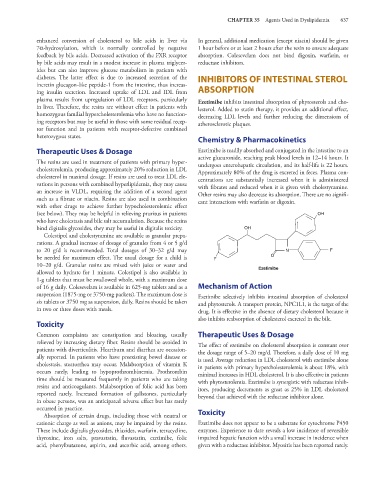Page 651 - Basic _ Clinical Pharmacology ( PDFDrive )
P. 651
CHAPTER 35 Agents Used in Dyslipidemia 637
enhanced conversion of cholesterol to bile acids in liver via In general, additional medication (except niacin) should be given
7α-hydroxylation, which is normally controlled by negative 1 hour before or at least 2 hours after the resin to ensure adequate
feedback by bile acids. Decreased activation of the FXR receptor absorption. Colesevelam does not bind digoxin, warfarin, or
by bile acids may result in a modest increase in plasma triglycer- reductase inhibitors.
ides but can also improve glucose metabolism in patients with
diabetes. The latter effect is due to increased secretion of the INHIBITORS OF INTESTINAL STEROL
incretin glucagon-like peptide-1 from the intestine, thus increas-
ing insulin secretion. Increased uptake of LDL and IDL from ABSORPTION
plasma results from upregulation of LDL receptors, particularly Ezetimibe inhibits intestinal absorption of phytosterols and cho-
in liver. Therefore, the resins are without effect in patients with lesterol. Added to statin therapy, it provides an additional effect,
homozygous familial hypercholesterolemia who have no function- decreasing LDL levels and further reducing the dimensions of
ing receptors but may be useful in those with some residual recep- atherosclerotic plaques.
tor function and in patients with receptor-defective combined
heterozygous states.
Chemistry & Pharmacokinetics
Therapeutic Uses & Dosage Ezetimibe is readily absorbed and conjugated in the intestine to an
active glucuronide, reaching peak blood levels in 12–14 hours. It
The resins are used in treatment of patients with primary hyper- undergoes enterohepatic circulation, and its half-life is 22 hours.
cholesterolemia, producing approximately 20% reduction in LDL Approximately 80% of the drug is excreted in feces. Plasma con-
cholesterol in maximal dosage. If resins are used to treat LDL ele- centrations are substantially increased when it is administered
vations in persons with combined hyperlipidemia, they may cause with fibrates and reduced when it is given with cholestyramine.
an increase in VLDL, requiring the addition of a second agent Other resins may also decrease its absorption. There are no signifi-
such as a fibrate or niacin. Resins are also used in combination cant interactions with warfarin or digoxin.
with other drugs to achieve further hypocholesterolemic effect
(see below). They may be helpful in relieving pruritus in patients OH
who have cholestasis and bile salt accumulation. Because the resins
bind digitalis glycosides, they may be useful in digitalis toxicity. OH
Colestipol and cholestyramine are available as granular prepa-
rations. A gradual increase of dosage of granules from 4 or 5 g/d
to 20 g/d is recommended. Total dosages of 30–32 g/d may N F
be needed for maximum effect. The usual dosage for a child is F O
10–20 g/d. Granular resins are mixed with juice or water and
allowed to hydrate for 1 minute. Colestipol is also available in Ezetimibe
1-g tablets that must be swallowed whole, with a maximum dose
of 16 g daily. Colesevelam is available in 625-mg tablets and as a Mechanism of Action
suspension (1875-mg or 3750-mg packets). The maximum dose is Ezetimibe selectively inhibits intestinal absorption of cholesterol
six tablets or 3750 mg as suspension, daily. Resins should be taken and phytosterols. A transport protein, NPC1L1, is the target of the
in two or three doses with meals. drug. It is effective in the absence of dietary cholesterol because it
also inhibits reabsorption of cholesterol excreted in the bile.
Toxicity
Common complaints are constipation and bloating, usually Therapeutic Uses & Dosage
relieved by increasing dietary fiber. Resins should be avoided in The effect of ezetimibe on cholesterol absorption is constant over
patients with diverticulitis. Heartburn and diarrhea are occasion- the dosage range of 5–20 mg/d. Therefore, a daily dose of 10 mg
ally reported. In patients who have preexisting bowel disease or is used. Average reduction in LDL cholesterol with ezetimibe alone
cholestasis, steatorrhea may occur. Malabsorption of vitamin K in patients with primary hypercholesterolemia is about 18%, with
occurs rarely, leading to hypoprothrombinemia. Prothrombin minimal increases in HDL cholesterol. It is also effective in patients
time should be measured frequently in patients who are taking with phytosterolemia. Ezetimibe is synergistic with reductase inhib-
resins and anticoagulants. Malabsorption of folic acid has been itors, producing decrements as great as 25% in LDL cholesterol
reported rarely. Increased formation of gallstones, particularly beyond that achieved with the reductase inhibitor alone.
in obese persons, was an anticipated adverse effect but has rarely
occurred in practice. Toxicity
Absorption of certain drugs, including those with neutral or
cationic charge as well as anions, may be impaired by the resins. Ezetimibe does not appear to be a substrate for cytochrome P450
These include digitalis glycosides, thiazides, warfarin, tetracycline, enzymes. Experience to date reveals a low incidence of reversible
thyroxine, iron salts, pravastatin, fluvastatin, ezetimibe, folic impaired hepatic function with a small increase in incidence when
acid, phenylbutazone, aspirin, and ascorbic acid, among others. given with a reductase inhibitor. Myositis has been reported rarely.

